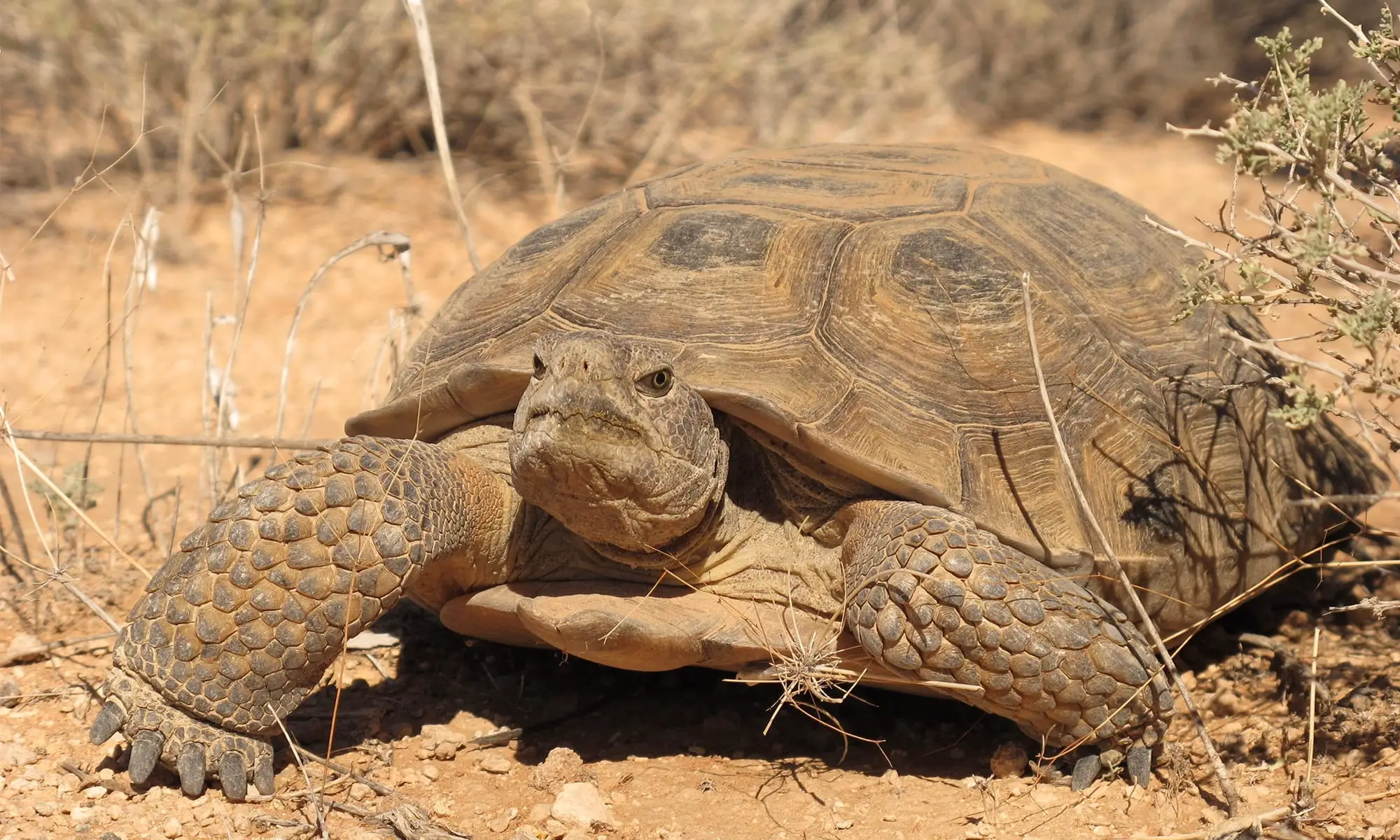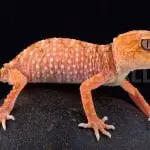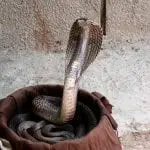Scientific Facts
| Common Name: | Gopher Tortoise |
| Scientific Name: | Gopherus Polyphemus |
| Life Span: | More than 20 Years |
| Size: | 12-16 inches in length |
| Habitat: | dry, sandy uplands, |
| Country of Origin: | North America |
Physical Description
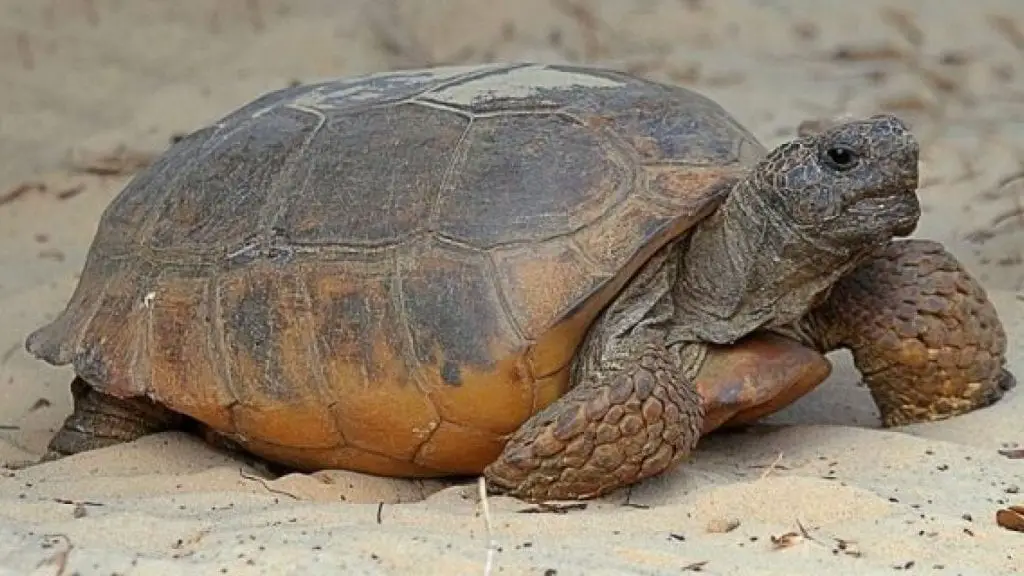
Gopher tortoises are moderate in size, having 23 to 28 centimeters of carapace on average and 38.7 cm maximum. Its average mass reaches 5500 grams. They are known for having feet that are flat, unwebbed, and stump-like ones and their forelimbs look like shovels intended for digging. Their carapace is oblong, and it is gray, tan, or brown. Their plastron is unhinged and has a pale brown and dull yellow color. For younger tortoises, their carapace is very smooth. The hatchlings have yellow carapace at the center and bordered by brown color. Their plastron is orange and yellow.
When sexually mature, both sexes will look similar in terms of the appearance of size. Nonetheless, they can be differentiated by the concave on their shells. Males have concavity, but females have a lower shell that is flat. In addition, males have mental glands that are longer and larger found on the frontal part of the plastron.
Geographic Range
Gopherus Polyphemus is found in the United States, particularly in the southeastern parts. It is extended to the Coastal Plains of South Carolina and ends of Louisiana. They are mostly found in Florida. A smaller portion is found in Mississippi, Georgia, and Alabama.
Habitat
Gopher tortoises like habitats that are sandy and well-drained like having coastal dunes, Pine Flatwoods, scrub, hammocks, scrub, and more. in addition, you can see them in urban areas and pastures. The sandy soils and are suitable for nesting and digging.
Meanwhile, the presence of abundant plants is for forage, and the sunny open areas are for basking and nesting. The forest fires in their habitats lead to the growth of more herbaceous plants. They burrow as deep as 4.5-meter-long on average and 2 meters in depth. Their burrows keep a steady humidity and temperature the whole year. The burrows serve as protection from fires, hot temperatures, and predators, as well.
Pine-oak Sandhills
Gopher tortoises are found in pine-oak sandhills at its high density. They are extended over the coastal plains of the United States, especially in the southeastern parts. Longleaf pines dominate this area.
Pine Flatwoods
These tortoises are seen also in at high densities of the pine Flatwoods. It has an open canopy of slash pine and longleaf. It occurs on a flat topography. The soils are poor to moderately drained. They support layers of shrubs that are well developed and fewer forbs and grasses. Gopher tortoises occupy frequently the pine flat woods. These are communities which are fire-maintained
Scrub
Gopher tortoises are seen at scrub’s moderate densities most of the time in open areas disturbed or ecotonal. Oaks dominate scrub.
Habitat Management
To manage their habitat, reducing the overstory trees, increasing the light amount, and improving the herbaceous forage’s quality is the focus. To reduce the canopy closure includes grazing, mowing, herbicides, prescribed fire, and tree harvest.
Fire is seen as beneficial to the tortoise. Fire helps nutrient release, reduce trash, increase sunlight, and scarify seeds. The right timing to give treatment is important. Gopher tortoise must be in their burrows during the conduct of the treatment.
In spring, they forage in the midday and afternoon. In the summer, they bask and forage in the early morning or late in the evening. They may also travel to moist areas during the summer. In the fall, they forage and stay in their burrows. They eat legumes and ripe fallen fruits. In the winter, they stay in their burrows for more days or weeks. They also eat herbaceous plants this season. Winter is the best time to do the management activities.
The lifespan of Gopher Tortoise
In the wild gopher tortoises can live 40 to 60 years, and may live over 90 in captivity.
Life Cycle
Stage 1: Eggs
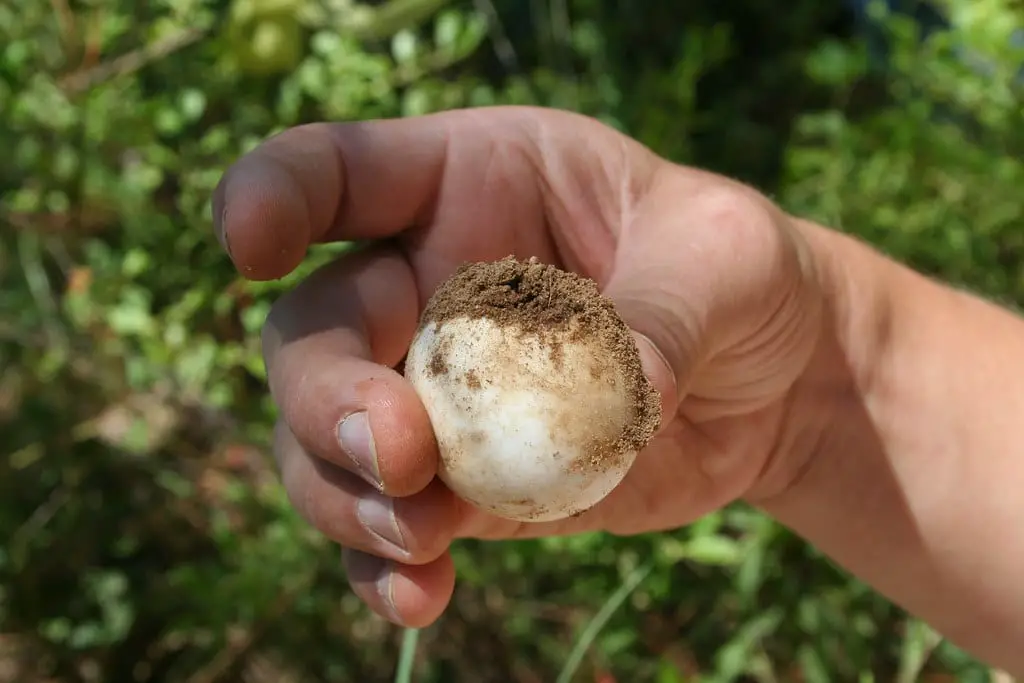
The eggs are mostly laid in holes found in the sand or mud. The females bury their eggs. They don’t stay near them to protect them.
Stage 2: Hatchling
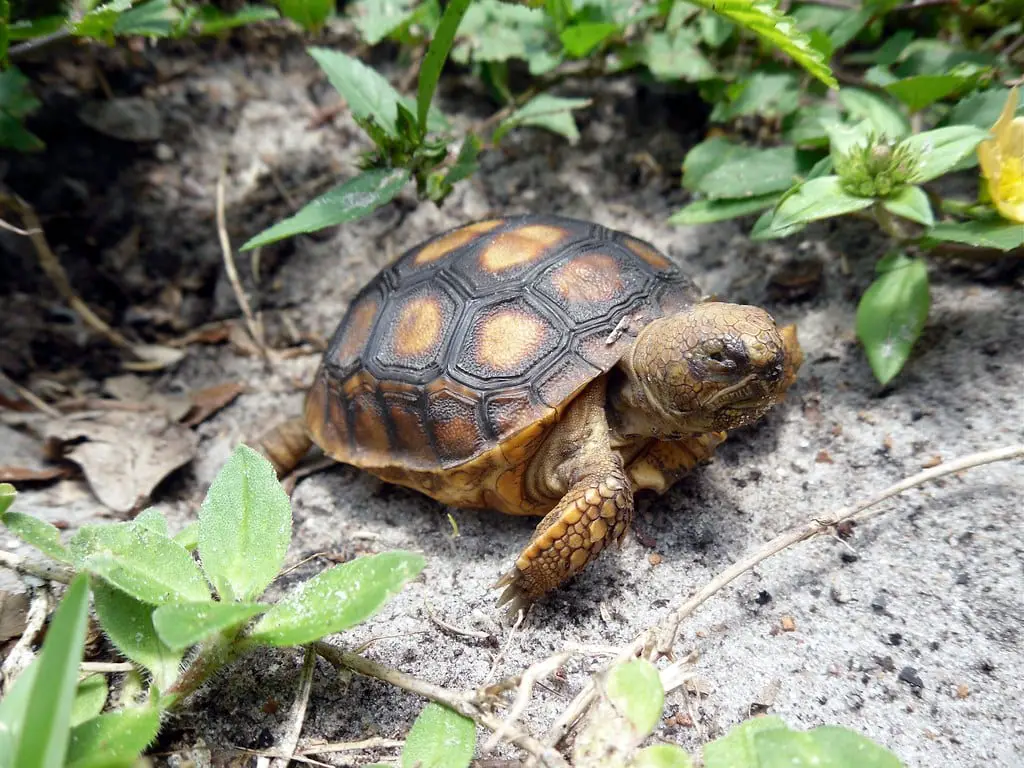
The temperature is the determinant of gender. Males emerge from cooler temperatures, while females are from warmer temperatures. They use their teeth in order to break the eggshell then goes to the water immediately. They live in the ocean during the first years of their life. They hide in their shells to protect themselves from predators.
Stage 3: Adult Turtle
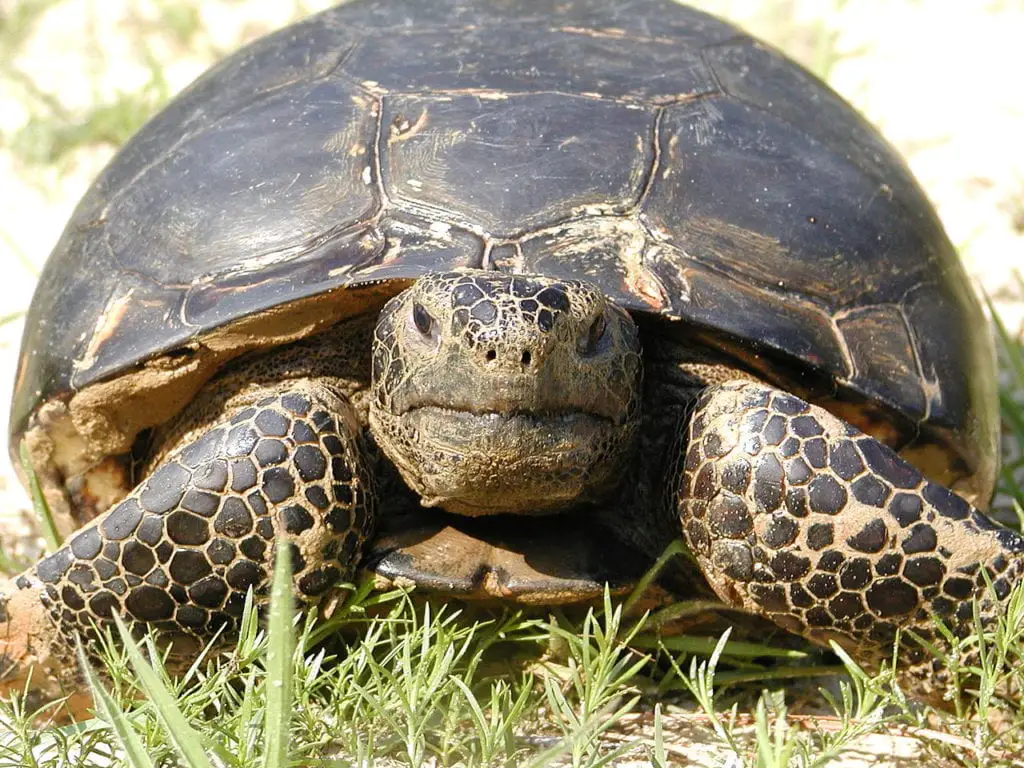
The adults can live both in water or land. The male rubs its body on the female and nods up and down. They are 5 inches long and weighs 1.400 pounds.
Behavior
Gopher tortoises depend on the sun to get the necessary warmth for their activities daily and seasonally. They stay active the whole year and remain more active from April to June, then in September until October. They are diurnal. In the winter, they are dormant when the temperature is low.
They spend 80% on burrowing. They leave their burrow to forage and bask when the condition outside is appropriate. To borrow, they need lower than 21 degrees Celsius and higher than 32 degrees means staying in the burrow. The extremely low and humidity limit their activity. They depend on their environment in maintaining the temperature of their bodies.
Every tortoise has a home range that’s well-defined, having some burrows. The males will travel to farther distances than females. The size of their home depends on the vegetation. The more vegetation there is, the smaller the range is. They nest in sunny and open locations in the sand. The incubation takes 80-110 days, and it emerges from August to November.
Tortoises don’t show maternal care to their young or eggs. They are herbivorous. They are fed on wiregrass, legumes, gopher apple, and broadleaf grasses. They change their diet based on the availability of forage. The forage is in 160 ft of the burrow. They drink enough amount of water from the forage plants.
Daily Activity
Gopher tortoises spend the night in their burrow and emerge at daytime to bask and feed. Their daily activities are affected by their environment and temperature because they are ectotherm. If the temperature is lower than 10 degrees Celsius, then they stay inactive inside the burrow. If it’s otherwise, then they go out and bask.
Basking is important to maintain digestion and elevate their body’s temperature. When their body temperature goes up, they seek water or shade and go back inside to cool themselves down. They get inactive if the temperature is high. they become bimodal or unimodal depending on the weather patterns in the region. The adults and juveniles have similar patterns daily.
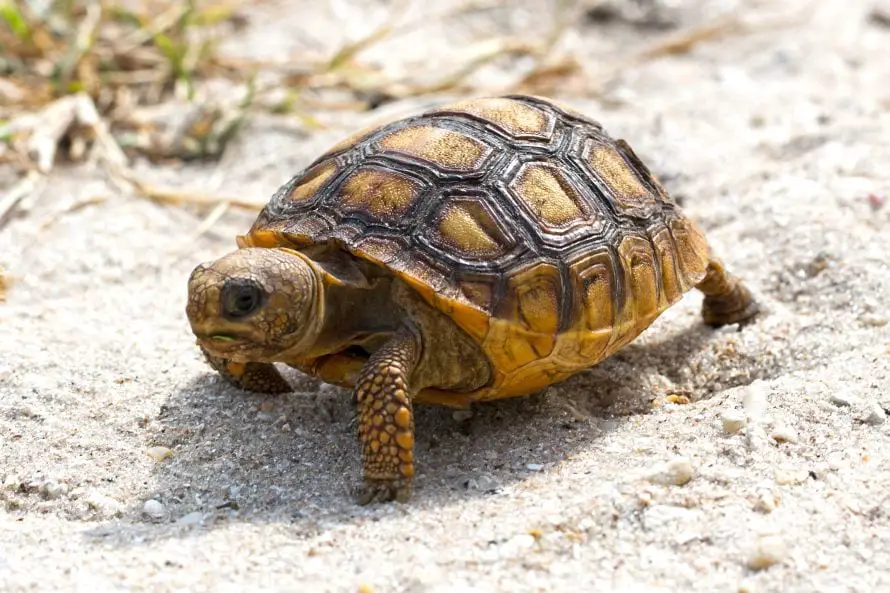
Annual Activity
Similar to their daily activity, their activity annually relies highly on the conditions of the environment. Their annual pattern activity varies geographically. That depends on the winter’s severity. The northern gopher tortoise is inactive in the winter months from January to March. They occur from South Carolina and Louisiana. The southern gopher tortoise, which is active, comes from the south of Florida.
In the winter, they bask at the burrow’s mouth when the days get warmer. Gopher in all regions remains inactive when it gets cold, dry, or very hot. They are found highly active from April to October and especially from April to June, then from September to October.
Latitude influences the nesting and time of breeding. Moreover, air and soil variation and rainfall and more are also factors. Their courtship in the spring is from April to early June. Nesting happens from spring to summer. Hatching is from August to October.
Long-Distance Movement
Gopher tortoise normally travels just short distances in the ranges of their home but can travel long distances infrequently. Male adults move 3 to 474 meters while the females move 0 to 186 meters.
Because of their mobility, their response to the change in environmental conditions is fast. They rapidly colonize. Their large movements are for foraging for food seasonally like fruits, seeds, and flowers as well the for the breeding of males, nesting for females and migrations done seasonally and others.
Dispersal happens in all ages. Adults disperse more than hatchlings. Hatchlings don’t disperse from where they were born or also called as natal areas. If it happens, it doesn’t happen for some years after they are hatched. It takes slow movements. When the hatchlings disperse, their movement is random.
Adults dispersal, especially the male, is farther and more directed. It happens when the reproduction period starts. They travel for 3 to 4 miles away from their colonies. It was suggested that the sub-adult male tortoise has more tendency to be dispersed or forced of breeding compared to the other ages and gender, but there is no proof of dispersal movement is a way of competing among males to find a mate.
Food and Diet
They are an herbivore. Most of their food is grass. It includes roots and young shoots of herbaceous plants found in the forage. They may eat pine needles, dry grasses, mosses, carrion, and more. They get water from the food they eat, but they also drink water when there is availability. One gopher tortoise can eat plant species of 160 to 400. Legumes and grasses have importance in their diet, especially to the young ones. They eat more legumes and fewer kinds of having thorns.
Grasses are mostly consumed when forbs are not available in some months. Young tortoises show a higher and faster rate of metabolism, and demand for protein. When their habitat is burned, threeawn is the first grass that grows. This is preferred by gopher tortoise, but it is no longer preferred when other forbs or legumes are available.
Social Interactions
Normally, gopher tortoises prefer staying alone, but lives in the cluster having home ranges that overlap. They are called colonies. A colony has more than 50. Subdivided colonies are termed as pods. It consists of aggregated tortoises plus their burrows. There are higher interactions in the pod, and the interaction among the pods is greater, too, compared to those between the colonies.
In terms of hierarchy, dominance has a tendency to occur. They protect their burrows as well as their feeding area, especially when breeding season comes. To show defense, they show defensive and aggressive pose like ramming and charging. The dominant behavior and reproduction determine the male’s burrow and movement. Males are active, more aggressive, and have a wider range. They spend more of their time to walk. They are the defenders of their burrow for the whole season of breeding. They also
Reproduction and Development
The geographic location, as well as local conditions, affect the age and body size for the first reproduction. Their sexual maturity can be reached with the carapace’s length at 7.1 to 15.2 inches for females and 7.0 to 11.8 inches for the males
Their eggs take sixty days in the uterus to be developed. Females produce one clutch a year. The number in each clutch varies. The heavy rainfall and fall are contributors to the decline in the reduction of the clutch size. Usually, a clutch has five to eight eggs and is related to the female’s length of the carapace. Larger carapace means a larger clutch. Hatching time takes 80-100 days. The eggs don’t hatch together sometimes. Hatching to an emergency occurs in more than one to twenty days. The survivors vary depending on the location. Parent tortoises don’t give parental care.
When hatched, the neonates will be 1.3-2.2 inches long. Then the sac of the yolk will be absorbed in 1-3 days. Neonates don’t do forage for forty-eight hours when the yolk sac is absorbed. Neonates will be hatchlings once it forages and absorbs the yolk sac. That happens two days to two weeks after hatching. Those who have soft gels are the juveniles, neonates, and hatchlings, while hard shells are for the adults and sub-adults.
To differentiate age, check the coloration, size, shape, and carapace. Differentiation of sex uses the external characteristics, including the concave plastrons of the males. Adults show territorial defense, mating, and courtship.
Mating
A male gopher tortoise is polygynous. It will have multiple mates. Mating starts from April to November, but the peak is from August to September. The males visit the females and make calls by rasping to attract females. They will have a fight as part of their courting. Eggs are laid from the middle of May until the middle of June.
One to twenty-five eggs is laid in the holes. The hatchlings will dig going to the surface after 100 days of emerging. The temperature determines the gender. For below 30 degrees Celcius that means male, higher than 30 means female.
Growth
Gopher tortoise’s growth is influenced by water’s availability, forage, weather, and age. There is a relationship between age and size. They reach sexual maturity more quickly. Increment growth works well to those tortoises with 4.7 to 7.5 inches of their carapace. In both sexes, the growth of the rate decreases gradually. The adult females grow larger than males.
Barriers to Movement
There are contributors to gopher tortoise’s movement. These are human infrastructures, cliffs, sinkholes, fissures, caverns, and more. in addition, a dense vegetation’s groundcover impedes their movements. Impeded movement affects reproduction and foraging.
Burrows
In gopher tortoise ecology, burrows are important. It is a refuge that defends and protects them from predators, fire, and changes in the season and temperature. As said before, they spend 80% of their time in their burrow. There, they rest and defecate. Still, when outside, their activities are centered around their burrows. Throughout the year, the humidity and temperature in the burrow are constant.
All gopher tortoise of age and class use burrows, but some juveniles and hatchlings bury themselves in sandy soils. They either make another borrow, use abandoned ones or reconstruct burrows that are damaged. A burrow is a tunnel that is a single channel. It slopes down from the surface of the soil. You will see a chamber in the deepest part. A burrow can be as long as thirty-five feet with 10 feet dept. A juvenile’s burrow is narrower, shallower, and shorter. For this reason, they are prone to predators. The apron is utilized for nesting and basking for the female ones.
Burrows are found on sandy soils, but it can be dug in a variety of soils. When dug in sandy soils, it is usually longer. High clay soils don’t support a big gopher tortoise’s population. When tortoise chooses a burrow, they base it on the distance of the soil’s surface to the groundwater table. They put a chamber near the groundwater table with a distance of 2 feet. It provides humid.
Gopher tortoises don’t burrow in areas where flood mostly happens. Apart from the type of soil, burrows also consider the vegetation. They choose where there is an abundance of plants. They choose sites that have moderate to very dense. They consistently choose burrow sites where there are shrubs and trees.
A gopher tortoise may have one or more burrows. It varies. Juveniles use fewer and male adults to use more compared to females. Many burrows are used consistently by the same tortoise for more than months or years. Others were used for a short time, while others are abandoned and reopened. In a study done, a female uses 2 burrows monthly from May until October and just one in other months.
Males use more borrows from May to September and get lesser in October. The burrows used in the summer and in the spring is not used already in the late summer. However, during the breeding season, females and males move less and use fewer burrows.
The occupancy and abandonment of burrow are influenced by environmental factors. The decrease in the number of food triggers, too hot, or too cold temperature are some reasons for abandonment. Again, gopher tortoises are solitary, but two or more can occupy one burrow.
If there is a limit in burrows, cohabitation happens. Young ones can tolerate cohabitation than adults. Forest are aggregated; as a result, gopher tortoise moves to smaller are in the period of breeding. After breeding, they disperse widely.
Nests
Gopher tortoise nests have six to twelve inches from the surface of the soil down to the bottom. They are found in open and sunny sites. They are mostly located near the female’s burrow and far from driveways, pits, and so on. Nests away from the burrows mean a type of response to the poor nesting condition. Females may also nest in the aprons of some abandoned burrows. It is not common for the females to dig a new burrow of relocation for laying an egg.
Ecological Significance
Gopher tortoises are seen to increase plant and local animal diversity. They are then characterized as keystone species. They build burrows and aprons that last for ten years. It increases the habitat and promotes richness in the plant species and diversity as mineral soils are exposed for the germination of other early-successional species.
They affect the flora around the burrows they make as they ingest seeds. Because they give a home to other animals, they contribute to the increase in the diversity of local animals. Other animals found shelter in the burrows. Beetles, crickets, and others have been found in the burrows. Skunks, bobcats also use abandoned burrows. The decline in the gopher tortoise population triggers the decline of the other animal species found in the same type of ecosystem.
Survival
The survival of gopher tortoise varies according to age class. There is a low rate from egg to juvenile because they are highly prone to predation. If the nests are not destroyed, there will be a high rate of survival. Hatchlings, neonates, and juveniles, all the vulnerable for having a softshell and just rely on protection from their burrow.
As soon as they have emerged from the nest, they are already vulnerable. Meanwhile, the sub-adult and adults are protected by the hard shells they have but are mostly affected by actions from humans. As a result, a high level of predation happens in areas having heavy human use.
The population is dominated by the large ones as caused by the low recruitment among the young and high rate of survival and lifespan of the adults and sub-adults. The highest rate of their population is recorded in the fire-adapted plants and ruderal habitats. That means there is a higher density in their population in the herbaceous area. The shift in seasonal habitat occurs among gopher tortoise. It happens between the fall and the spring.
For their reproduction in the spring, sunlit areas and well-drained soil are important. The decrease in shrub cover and tree leads to an increase in the gopher tortoise’s density. In addition to habitat, a high population density means a stressed population.
Threats
Humans serve as predators to the gopher tortoise. Some eat gopher tortoise’s meat. Poor people eat them. Furthermore, they are taken as pets. They are prevented from reproducing. They are also used for races.
Climate change is another threat. The rise in temperature and changing patterns of rainfall increases the invasive species. It could drive out the plants which are necessary for the diet of the tortoise. Warm temperatures create the rising of sea level and the occurrence of a storm. Too much rainfall or drought causes fewer land availability. Just an increase of one meter in sea level is the cause of loss of conservation lands and natural habitats.
Human urbanization causes a decline in gopher tortoise’s population, so then they are listed as endangered. The loss of habitat is increasing because of the growth of the human population and the expansions of constructions. The European settlement caused the loss of longleaf pine, a suitable habitat for our tortoise. The development of agricultural lands and unused lands will lead to water competition between humans and animals, as well as the extinction of the ecosystem for the tortoise.
Gopher tortoises are prone to diseases in the upper respiratory tract. This is caused by microorganisms. The symptoms are conjunctivitis, discharges, and more. Enrofloxacin is used to treat it.
Conservation and Management
The gopher tortoise is classified as a Threatened species. The goal is then to restore and maintain the population. It can be attained by minimizing the loss of gopher tortoises, increasing and improving their habitat, enhancing and restoring their population, and maintaining their function as the keystone species.
If you see one crossing a rod, you are permitted to move it across the road. Don’t move it to another location. Learn more about them and their habitat. Discourage your friends from taking them or moving them. Know about the good effect of fire and tools to give a healthy condition.
Special Interests
The genus name of this tortoise if a Latin term for a mammal that is small and burrows. The Polyphemus is a giant creature in the story of Odysseus. It is applied to this tortoise because it burrows, and it is strong. They dig under making wide chambers. Through burrowing, the nutrients that leached are brought back. They dispense seeds for some native plants.
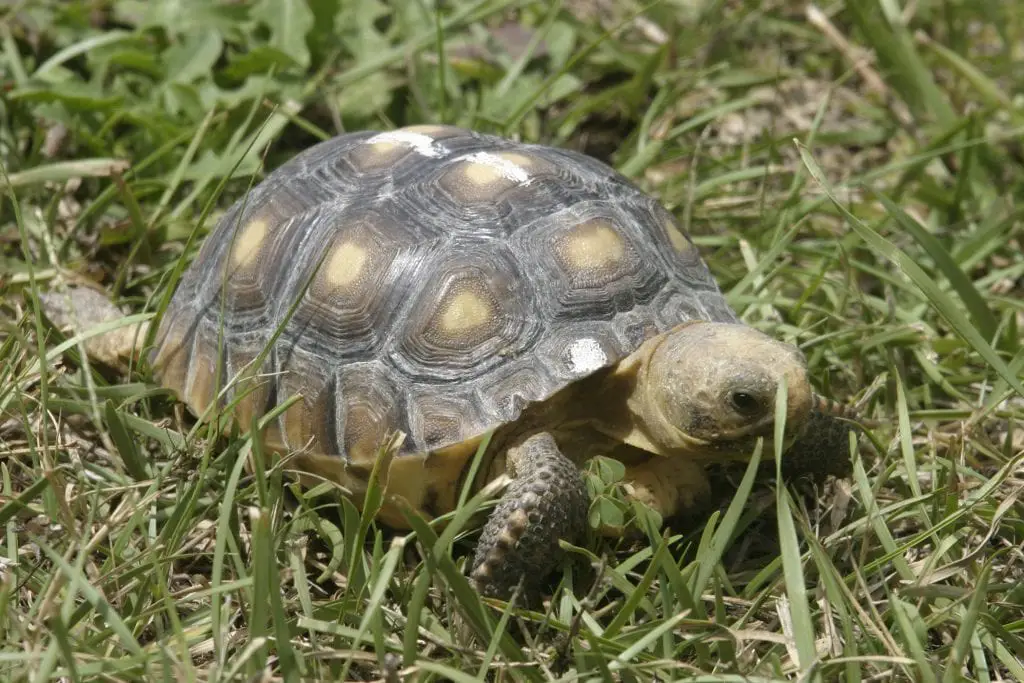
Fun Facts
- They make large burrows. Not all tortoises can do it. They hide under burrows or vegetation.
- They are ectothermic. They fail to regulate their own temperature. Thus, they rely on the environment for temperature. They bask under the sun.
- Their mouth has the shape of a half-moon.
- They burrow 80% of their life.
- The native Americans used their shells for helmets, baskets, and pots.
- You don’t see them drink water from standing water. They use their legs for the water to run down their burrows. They get water from the food they eat.
- Gopher tortoises cannot or swim very poorly since they are a land-based tortoise.
- Property owners must get a permit if there is a need for relocating the gopher tortoise before clearing or development must be done.
- The oldest recorded gopher tortoise is Gus. Its age is 96. He is a Museum of Natural History at Halifax Nova Scotia.
Health Problems and Prevention
The common cause of health problems among them is the upper respiratory tract. It is caused by a bacterium. Watch out for the discharge of mucus and pus. They also have conjunctivitis. If the tortoise is infected. Don’t let it be in captivity with others. it should not be released back to the wild as it will only spread the problem.
How to Care for Gopher Tortoise
1. Don’t rely on the green so much. Those are for humans and not for the pet. They contain high sugar and has a low fiber content. It can be bad for your tortoise.
2. Keep them from their predators like skunks, feral cats, dogs, raccoons, and more. Give them a suitable habitat or housing.
3. Learn the laws in your locality. You need a permit.
Availability – Where to Get One?
You can buy or purchase the gopher tortoise at pet stores that especially sell reptiles, or you may also check some online sites or sources on the internet or local stores as another option.
FAQ Section
What are the features of the gopher tortoise that makes it unique?
They are unique, for they are the only species of land tortoise seen on the Mississippi River. They can live for over 60 years old. They are identified for their feet, coloring, and beaks, which are non-protruding. They are the keystone species. Because of the 350 species depend on them. Their burrows are home to other animals.
What type of soil do gopher tortoises often dig their homes in?
They dwell in sandy and well-drained soils.
Do they leave their footprints in the sand?
Yes, they do, but in soft sands only.
How much land does a gopher tortoise use?
A gopher tortoise can use wide acres of habitat. They use this for nesting, mating, and nesting. They can have more than one burrow.
How do I know if I’m looking at a gopher tortoise burrow?
Their burrows are half-moon shape. The larger the opening of the burrow is, the larger the tortoise there is.
How deep do gopher tortoise burrows go?
Their burrow has 7.5 feet deep with 15 feet long. The biggest was a 20 ft. deep and 50 ft. long.
What is a commensal?
They are species who get benefited by the gopher tortoise. They don’t harm the tortoise. Some don’t exist without the gopher tortoise. Sometimes the gopher tortoise also benefits from the commensal like eating parasites in the burrow.
Do the other animals hurt the tortoises?
Most of the animals don’t hurt the gopher tortoise and vice versa. They live all together in an ecosystem that’s balanced. While they are young, their shell is soft, and they can be eaten by predators like raccoons or other animals. The older ones have the tendency to get ticks and mites in their bodies and few predators.
Where can I see gopher tortoises in Florida?
They are found all over Florida, particularly in the sandhills and longleaf pine areas.
Is the gopher tortoise an endangered species?
Yes, they are. They are among the threatened species. If there are no protection or conservation plans and actions for them, they would totally go extinct. Protection of the burrow is also protected the state law in Florida.
Did gopher tortoises live with the dinosaurs?
No, they didn’t. They are part of land tortoise that came from North America about sixty million years ago, while the dinosaurs were extinct sixty-five million years ago.
Can you have them as pets?
No, you cannot since they are listed as threatened they should be in the wild. It is illegal to have one without getting a permit.
What kind of plants do gopher tortoises eat?
They eat plants that are leafy like wiregrass, leaf grasses, and more. they are opportunistic eaters. They can eat what they find. They even eat excrement, crabs, and small insects too.
How much food do gopher tortoises eat? Do they eat fast? Do they have to eat each day? Do they slow down their consumption of food during the winter?
The food amount depends on the age, size, year, and time of the gopher tortoise. In winter, their metabolism gets slow.
Do gopher tortoises fart? Does their poop stink?
Yes, they do fart. They poop everywhere and anywhere in their own burrow. Like all poops, it also smells.
Do they bite?
Yes, they do if you put that finger near the mouth. When they are threatened, they hide in their burrows as an initial reaction.
Male/female differences—where are eggs developed and stored inside the female before she lays the eggs?
The males’ sperm are kept in the plastron or underbelly. It stays there until the mating. Females have flat plastron.
Where do gopher tortoises lay their eggs? Is there a diagram of the nesting site?
Females lay eggs in a place that’s sandy and sunlit to give them heat. Many choose to lay eggs in the apron or in front of their burrow.
How are the nesting sites dug by the females? Do they use front legs or back legs to dig?
The female gopher tortoise digs their using both their legs in front and at the back.
How hard are the eggshells?
The shells are round and so brittle. The size is similar to a ball of ping pong.
How do the baby tortoises break out of the shells? When they hatch, do they leave the nest one at a time or in a group? What happens next?
To break out their shells, they use their egg tooth. This is a sharp point located on their nose. It must be incubated for 70 to 100 days. The temperature determines sex. It will be hatched for the next twenty days. The eggs are vulnerable to raccoons.
Which are bigger males or females?
The female gopher tortoise grows bigger than the male ones.

